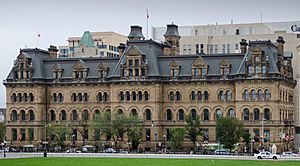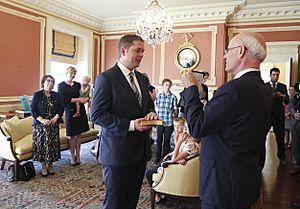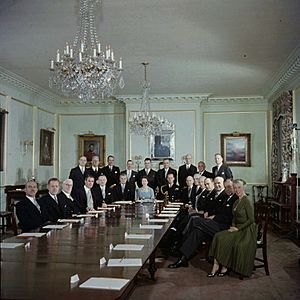King's Privy Council for Canada facts for kids
|
Conseil privé du Roi pour le Canada
|
|

The Office of the Prime Minister and Privy Council building is the seat of the Privy Council
|
|
| Abbreviation | PC |
|---|---|
| Formation | 1867 |
| Legal status | Advisory body |
|
Membership
|
List of current members |
| Charles III | |
|
President
|
Dominic LeBlanc |
|
Clerk
|
John Hannaford |
The King's Privy Council for Canada (also called the Privy Council or PC) is a special group of advisors to the King or Queen of Canada. This group helps the King or Queen with important decisions about the country. Even though the King or Queen is the head, they usually follow the advice of a smaller group called the Cabinet. The Cabinet is made up of elected members of Parliament who are also part of the Privy Council.
People become members of the Privy Council for life. The Governor General appoints them, usually on the advice of the Prime Minister. Most members are former Cabinet ministers. Some others are invited as a special honour. Privy Council members get a special title and letters after their name.
Contents
How the King or Queen Governs Canada
The Canadian government is officially known as "His Majesty's Government." It works with the King or Queen acting on the advice of the Privy Council. This is often called the "Governor-in-Council," because the Governor General acts on behalf of the King or Queen.
The main job of giving advice to the King or Queen and Governor General falls to the Cabinet. The Cabinet is a smaller committee within the Privy Council. Its members are usually ministers who are also elected to the House of Commons. This means they are responsible to the people through Parliament.
The Cabinet handles the everyday running of the government. But for very important national events, like announcing a new King or Queen, more senior members of the Privy Council might meet. These meetings could include the Prime Minister, the Chief Justice, and other important leaders. While all Privy Council members are invited in theory, the Prime Minister usually decides who attends. At least four members must be present for a meeting to be official.
Who Belongs to the Privy Council?
The Constitution Act, 1867 says that the Governor General appoints people to the King's Privy Council for life. This is done on the advice of the Prime Minister. Most members are current or former government ministers.
Other important people also become members. These include the Chief Justice of Canada and former Governors General. The Leader of the Official Opposition and leaders of other opposition parties are sometimes appointed. This can be an honour or to allow them to see secret information. Also, members of the Security Intelligence Review Committee must be Privy Council members.

When someone joins the Privy Council, they must take an oath. This oath promises loyalty to the King or Queen and to keep all council matters secret.
I, [name], do solemnly and sincerely swear (declare) that I shall be a true and faithful servant to His Majesty King Charles III, as a member of His Majesty's Privy Council for Canada. I will in all things to be treated, debated and resolved in Privy Council, faithfully, honestly and truly declare my mind and my opinion. I shall keep secret all matters committed and revealed to me in this capacity, or that shall be secretly treated of in Council. Generally, in all things I shall do as a faithful and true servant ought to do for His Majesty.
Provincial leaders (Premiers) are not usually appointed. But they have been made members for special events. For example, this happened during Canada's 100th birthday in 1967. It also happened when Canada's constitution was brought home in 1982. In 1992, Governor General Ramon Hnatyshyn appointed 18 famous Canadians to the Privy Council. These included a former Premier, a hockey star, and a businessman.
Members of the Royal Family have also joined the Privy Council. These include Prince Edward (who later became King Edward VIII), Prince Philip, Duke of Edinburgh, and Prince Charles (now King Charles III).
Sometimes, people who are not Canadian have been appointed. For example, Billy Hughes, the Prime Minister of Australia, joined in 1916. Winston Churchill, the Prime Minister of the United Kingdom, joined in 1941. This was done to honour them and allow them to discuss important matters.
Special Titles for Members
Privy Council members are called "the Honourable." Very important members, like the Prime Minister or Chief Justice, are called "the Right Honourable." They also use the letters "PC" after their name.
Before 1967, only Canadians appointed to the British Privy Council in London used the title "the Right Honourable." These were usually prime ministers, chief justices, and senior Cabinet members. This practice ended, but the title "the Right Honourable" is still used for Canadian prime ministers and chief justices.
History of the Privy Council
In the early years after Canada was formed in 1867, the Privy Council met often. The Governor General would lead these meetings. For example, in 1873, Governor General the Earl of Dufferin led a meeting. He explained how Parliament would be temporarily stopped during a political scandal. Later, Governor General John Campbell, Marquess of Lorne, stopped the practice of the Governor General leading regular Privy Council meetings. Now, they only lead meetings for special ceremonies.
In 1947, Prime Minister William Lyon Mackenzie King had the Privy Council meet. They met to approve the marriage of Princess Elizabeth (later Queen Elizabeth II) to Philip Mountbatten. This showed that Canada's Crown was separate from the UK's.

The Privy Council has met with the King or Queen present only a few times. The first time was in 1957 at Rideau Hall, the monarch's home in Ottawa. Queen Elizabeth II led a meeting of 22 Privy Council members. She also appointed Prince Philip to the Privy Council at that meeting. Two years later, the Privy Council met with the Queen again in Halifax, Nova Scotia. This was to confirm Georges Vanier as Governor General. Prime Minister John Diefenbaker wanted these meetings to show that Elizabeth was Queen of Canada, separate from her role as Queen of the United Kingdom.
In 1981, another formal meeting of the Privy Council took place. This was to approve the marriage of Prince Charles (now King Charles III) to Lady Diana Spencer. Twelve people attended this meeting at Rideau Hall. They included the Chief Justice, the Prime Minister, and several ministers. They were told about the engagement, approved it, and toasted the couple. An official said that if the Privy Council had rejected the marriage, Charles's children would not have been considered heirs to the Canadian throne. This could have caused problems for the link between Canada and the Crown.
In 1992, Queen Elizabeth II led another meeting of her Privy Council. This was to swear in new members during her 40th year as Queen.
The most recent formal meeting of the Privy Council was on September 10, 2022. This meeting was held to officially announce King Charles III as the new monarch after his mother, Queen Elizabeth II, passed away.
See also
 In Spanish: Consejo Privado del Rey para Canadá para niños
In Spanish: Consejo Privado del Rey para Canadá para niños
Images for kids
-
Prince Edward (front row, fifth from left), at Rideau Hall, in Ottawa, two days after being appointed to the King's Privy Council for Canada


